IF and FL Diamond Clarity Grades
Why Flawless and Internally Flawless diamonds are not your best choice
We are reader-supported. Buying through any red colored link on our site may earn us commissions. Learn More.
Why Flawless and Internally Flawless diamonds are not your best choice
Flawless (FL) and Internally Flawless (IF) diamonds are the top clarity grades, which means that the diamonds have no visible flaws under 10x magnification (or even a microscope). Diamonds in this clarity range are rare, making up less than 0.5% of all diamonds. Interestingly, you can’t see the difference between these and lower-grade diamonds like VS2 and SI1 with the naked eye, but the price difference is significant. You’ll learn everything you need to know about FL/IF clarity diamonds in this article.
When you see a diamond labeled as Flawless (FL) or Internally Flawless (IF), you might think it’s the best diamond clarity to buy. The truth is, buying a diamond with such a high clarity grade won’t be noticed. Diamonds with lower clarity grades, such as VS2 and SI1 diamonds, appear eye-clean just like a flawless diamond but cost thousands of dollars less. So while FL and IF represent the peak of the clarity grade, they’re not a smart buy, since they’ll appear the same as lower-graded diamonds.
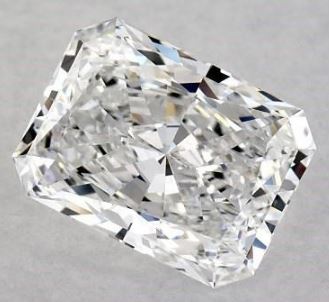
You certainly pay a premium for perfection. Take a look at this stunning one carat diamond from Blue Nile that is graded flawless. The flawless diamond commands a 47% premium even over a gorgeous diamond like this VVS1 clarity diamond also from Blue Nile.
Throughout our site, we talk about how diamonds shouldn’t be considered an investment, but you should still choose a diamond that gets you the most beauty and value for your money. By buying an FL or IF diamond, you’re spending money on something you won’t reap any return on.
Here’s what we’ll cover in this article:
What is an FL diamond?
What is an IF diamond?
What’s the difference between a FL and IF diamond?
How much do FL/IF diamonds cost?
Are FL/IF diamonds worth it?
FL/IF diamonds on the diamond clarity scale
Which clarity grade is best for purchase?
FAQs
Why you should trust us
An FL (flawless) clarity diamond like this one from Blue Nile shows no inclusions or blemishes even under 10x magnification. It’s the highest clarity grade and the rarest type of diamond clarity. Flawless diamonds represent less than a half percent of all diamonds on the market.
As the GIA laboratory puts it, “Evaluating diamond clarity involves determining the number, size, relief, nature, and position of these characteristics, as well as how these affect the overall appearance of the stone”. FL/IF stones have a complete absence of those characteristics.
Because diamonds undergo extreme conditions during formation over billions of years, diamonds are bound to have imperfections, even small ones. A flawless diamond still isn’t 100% pure and will have inclusions, but you need 60X or even 100X magnification to see them. A professional gemologist looks at the diamond under 60X magnification to determine if it’s flawless.
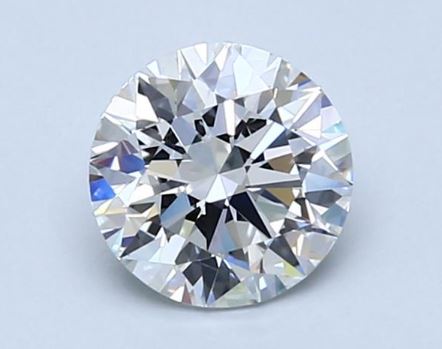
An IF (Internally flawless) diamond like this one from Blue Nile has no visible internal inclusions but might have slight blemishes on the stone’s surface. IF diamonds fall right below flawless diamonds on the GIA clarity scale. They’re extremely rare, just like flawless diamonds, and represent less than 1% of all diamonds. Only a professional gemologist can give an IF diamond its grading while looking at the stone under 60X magnification.
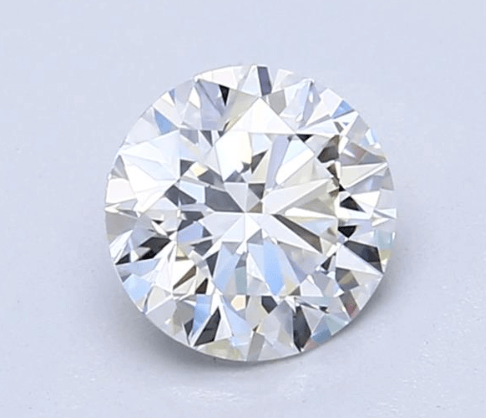
FL and IF diamonds are next to each other on the clarity scale, with FL being the highest grading. When FL and IF diamonds are viewed under 10x magnification, no imperfections are noticeable. The biggest difference is that unlike flawless diamonds, internally flawless diamonds have slight surface blemishes. An IF diamond, for instance, might have surface graining, extra facets or minor polish marks.
Without the help of magnification and a professional gemologist’s eye, no one can tell the difference between FL and IF diamonds. Even trained professionals can have a difficult time distinguishing the two.
Because of their rarity, FL diamonds cost anywhere from 25-35% more than IF diamonds. For instance, this 1.06 carat round cut FL diamond, F color from Blue Nile costs $14,160 while this 1.05 carat round cut IF diamond, F color diamond also from Blue Nile costs $9,430. The price difference is $4,730—a whopping 33% more.
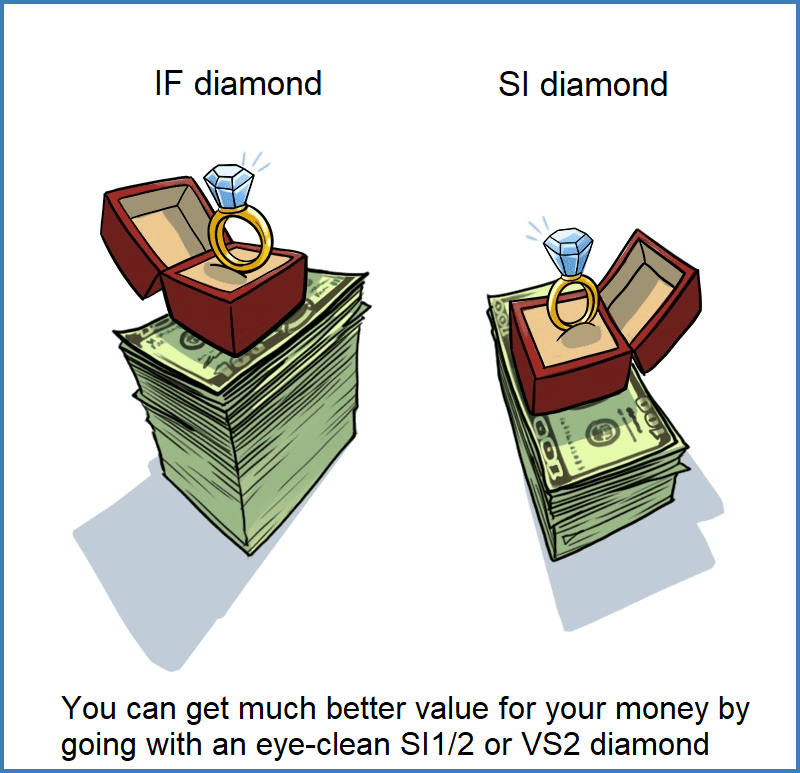
Overall, both IF and FL diamonds are incredibly rare, and their prices reflect that. As you increase in carat weight, the diamond price increases exponentially because larger FL and IF diamonds are even more rare. For example, this 1.30 Carat FL round diamond from James Allen costs $16,020 and this 2.09 carat IF round diamond also from James Allen is priced at $22,020.
Because flawless diamonds are so rare, the cost of a well-cut 1 carat round cut with a G-H Color ranges from $6,100 to $9,000. Larger flawless diamonds are even more rare, and their prices match that level of rarity.
While buying a top-tier clarity grading might seem like the best way to guarantee a beautiful stone, paying for an FL or IF grading is money poorly spent. Here’s why: no one will be able to tell that it’s an IF or FL diamond. You can find eye-clean stones at lower grades, like VS2 and SI1 graded diamonds.
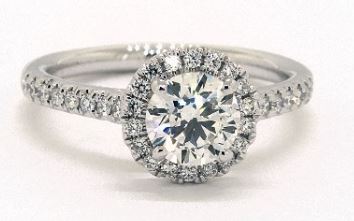
From a clarity standpoint, lower graded eye-clean diamonds will look identical to flawless diamonds but costs thousands of dollars less. For example, this 1.05 carat round cut G/VS2 diamond from Blue Nile costs $5,730, while this 1.05 Carat IF diamond in G color also from Blue Nile costs $8,610. With all other qualities being the same, the IF diamond costs $2,880 more. That’s a 33% difference!
IF and FL diamonds can only be identified under 60X or 100X magnification by an expert. Is that how you’ll be looking at your diamond? Probably not, so it’s simply not worth the price tag.
You’re far better off spending more of your budget on diamond cut. The quality of the diamond’s cut impacts the beauty and brilliance of your diamond more than any other aspect. An exceptionally cut diamond reflects white and colored light—making it a truly eye-catching stone.
While this article addresses the technical grading and value of FL & IF clarity diamonds, that is not what we recommend focusing on when purchasing a diamond. In our opinion, a consumer’s goal should be to find the cheapest (in regards to clarity; other factors matter as well) “eye-clean” diamond you can find. We use “eye-clean” to describe diamonds that may have inclusions if you look at them with a magnifying glass (or microscope or loupe), but the typical person can’t see the inclusion with their naked eye.
We have recently developed Ringo, a patented artificial intelligence model, that can examine videos of diamonds and determine if they are eye-clean. Ringo will also filter for other parameters like making sure the diamond is well-cut, doesn’t have fluorescence issues and will match the style setting you choose.


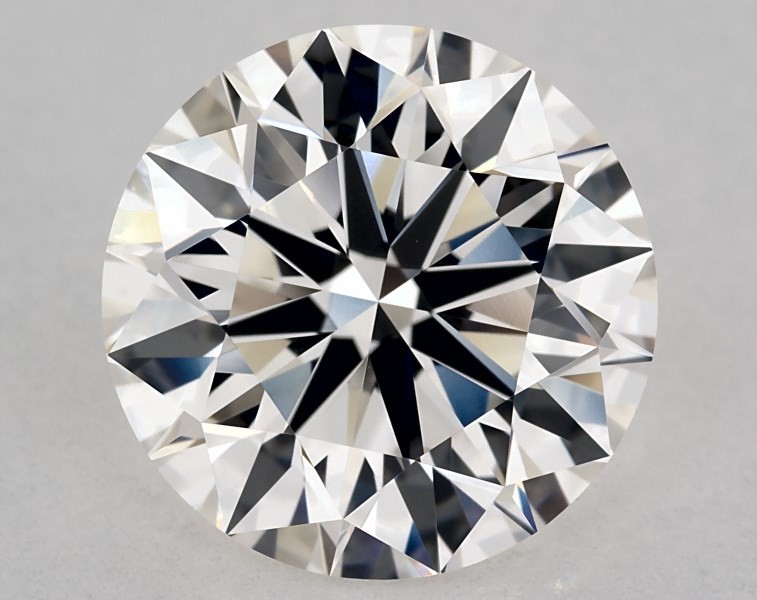
If you want to select a diamond specifically for your personal needs (budget, shape and setting style), check it out here.
Outside of FL and IF grades, there’s an entire diamond clarity chart. Clarity is one of the 4C’s of diamonds. Ranging from best to worst, the GIA grades diamonds as:
A diamond’s clarity tells you whether or not imperfections like blemishes and inclusions are present in the diamond. The location, type, size and quantity of imperfections all impact the clarity grade it’s given.
While clarity grade is important, it’s not the only factor for evaluating a diamond’s imperfections. You should look at every diamond (no matter the grade) to see if you notice any blemishes and inclusions. Diamond vendors like James Allen provide HD magnified photos so you can review each diamond closely. You can also ask an expert for their opinion.
In most cases, a VS2 or SI1 clarity will give you the best value. With an eye-clean VS2 or SI1 diamond, you’ll have a beautiful diamond without paying nearly as much as a higher-graded diamond. Depending on the carat weight and shape of your diamond, there are a few clarity grades to target to get the most out of your budget. You’ll still want to review each diamond closely yourself.
Here are the best clarity grades for each shape:
Round cut and princess cut diamonds: In general, an SI1 or VS2 clarity grade will be eye-clean (sometimes SI2 clarity won’t have visible inclusions either – only round cut). For diamonds over 2 carat, a VS1 or VS2 will still give you an eye-clean stone and cost much less than diamonds with VVS clarity. In general, the larger the diamond, the easier it is to see inclusions.
Oval cut, radiant cut, cushion cut, marquise and pear shaped: These shapes hide inclusions better than others, so aim for an SI1 or SI2 for the best value.
Asscher cuts, emerald cuts and baguettes: Because step cut diamonds show imperfections more easily, opt for a VS2 in these shapes to make the most of your budget.
Heart shaped diamonds: Choose a VS2 or SI1 clarity grade for the best value. Heart shape diamonds hide inclusions better than round cuts, but not as well as shapes like the cushion cut or oval cut.
We feel strongly that your budget is better spent paying for the highest tier on other qualities like cut. For clarity, you can find an eye-clean stone in a lower grade and pay a whole lot less. Choosing an FL or IF diamond is like throwing money down the drain.
Want to know more so you can make the best engagement ring purchase? Check out our other educational articles on everything from diamond color to carat weight.
Internally Flawless (IF) is one grade higher than VVS1 on the diamond clarity scale. That means these diamonds are “better” (in terms of their clarity and the level of visible imperfections) than VVS1 diamonds.
Flawless diamonds are incredibly rare. FL is as good as it gets for diamond clarity, and it’s estimated that less than 0.5% of all diamonds on the market are FL clarity.
FL diamonds are generally considered better than VVS diamonds, as FL is the highest possible clarity grade. However, you can argue that VVS diamonds are a better purchase, as they appear identical to FL diamonds under regular viewing conditions, but cost significantly less.
The best diamond clarity to get is the lowest grade at which a diamond still appears eye-clean, with no visible imperfections when viewed by the naked eye. This can be as low as SI2 in some cases but is more likely to fall in the range of VS2-SI1.
A nice one carat round diamond that is IF clarity costs about $7,000. The price can vary a bit based on which shape you select, what color grade you go with, and whether it’s well cut or not.




Before you buy a diamond, get personal buying advice from industry veterans. We'll help you get the best diamond for the money.
DISCLAIMER: We don't use your email for marketing. Period.
A diamonds’ price is determined primarily by the 4 Cs of the diamond. On the wholesale level, diamond prices are first based on a diamond shape and
Buying an engagement ring is often one of the first major purchases in a person's life. The process can be fraught with tension as there are so m
A wide range of 1 carat diamonds exist both in online markets and local diamond jewelry stores. Not only are there significant differences in beauty
Please enter your email address to receive your 25% off coupon code:
Here is your coupon code: GFDSF3GF